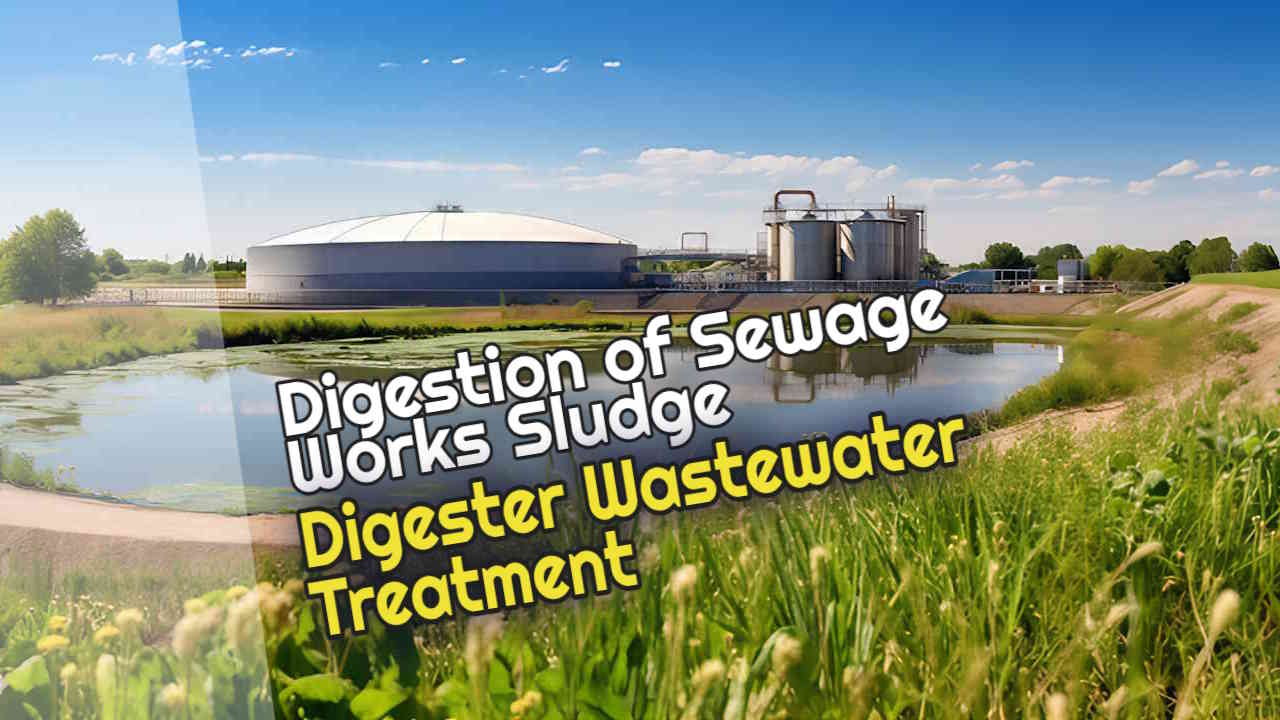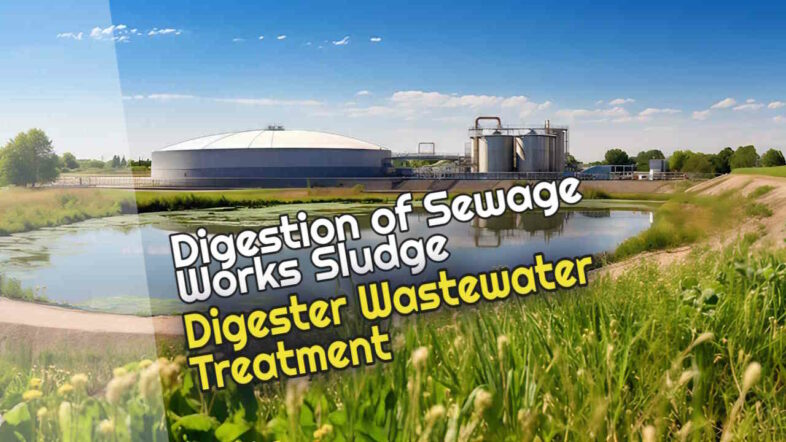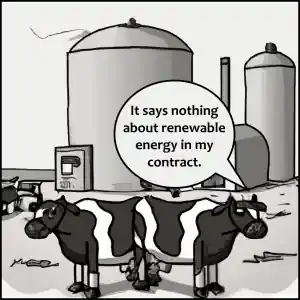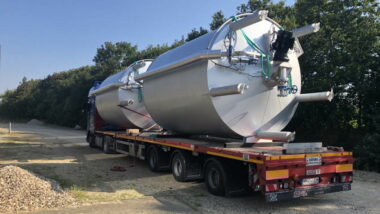Read this for an understanding of digester wastewater treatment, which, to most people, means the digestion of sewage works sludge. Yes. We are talking about the crappy solid matter in foul sewage!
But don't recoil from this subject because this detritus has great potential to assist the world in reducing greenhouse gas emissions!
Introduction
Dealing with wastewater sludge is a pressing issue affecting environmental sustainability and human health worldwide. Did you know that anaerobic digestion, a widely applied sludge treatment process, transforms this waste into valuable resources? Our article will guide you through the ins and outs of the digestion of wastewater sludge process, shedding light on its numerous benefits.
Stick around; these insights could tremendously transform your understanding of efficient waste management!
Key Takeaways
- Anaerobic sludge digestion is a crucial process in wastewater treatment that breaks down organic matter without the need for oxygen, resulting in biogas and digestate production.
- The benefits of anaerobic sludge digestion include energy generation through biogas production, reduction of sludge volume and disposal costs, nutrient recovery for agricultural use, and a significant reduction in greenhouse gas emissions.
- Implementing anaerobic digestion promotes efficient and sustainable sewage sludge management while contributing to renewable energy goals and environmental sustainability.

What is Anaerobic Sludge Digestion?
Anaerobic sludge digestion is the process of breaking down organic matter in wastewater sludge without the presence of oxygen, resulting in the production of biogas and a stable digestate.
Process of breaking down organic matter in wastewater sludge
The breakdown of organic matter in wastewater sludge is at the heart of anaerobic digestion, which happens to be a key component in waste management and treatment processes globally.
This prolonged and intricate sequence operates devoid of oxygen, converting organic compounds present in wastewater sludge into more stable substances. Naturally occurring microorganisms play a principal role here, as they feed on the organic material within the sludge during various stages, resulting in biogas production alongside digestate, both of which possess practical applications.
It's evident that understanding this vital process is crucial for environmental scientists, engineers and other stakeholders involved, as it leads to significant benefits such as potent greenhouse gas reduction, provision of renewable energy sources and consistent decrease of volume for the treated material – all promoting an efficient way to handle sewage sludge.

Importance of anaerobic digestion in wastewater treatment
Anaerobic digestion stands as a pivotal process in wastewater treatment, offering an environmentally sound and sustainable solution. The approach breaks down organic matter found in the sludge of sewage treatment plants without the need for oxygen.
This method not only simplifies tasks but also provides flexibility with lower costs compared to its aerobic counterpart. Amongst the most impressive aspects of anaerobic digestion is its ability to transform diverse types of waste, including municipal wastewater sludge into valuable resources such as biogas and digestate, highlighting it's wide-scale applicability.
As the demand for fossil fuels decreases through this process, operating costs dwindle resulting in substantial energy savings – a boon for waste management companies and municipalities alike.
Furthermore, by stabilising troublesome wastes within regulatory boundaries for reuse or disposal, odours decrease drastically while pathogen destruction increases significantly alongside biogas production skyrockets – ticking off multiple goals simultaneously.
In summary, understanding and implementing anaerobic digestion offers enormous advantages that ensure efficient and sustainable sewage sludge management – crucial not just for environmental regulators but scientists, agribusinesses and renewable energy industries too.
Benefits of Anaerobic Sludge Digestion
Anaerobic sludge digestion offers several benefits, including energy generation through biogas production, reduction of sludge volume and disposal costs, nutrient recovery for agricultural use, and a significant reduction in greenhouse gas emissions.

Energy generation from biogas production
Harnessing the power of biogas generated through anaerobic digestion is a breakthrough in renewable energy. This sustainable process converts wastewater sludge, an otherwise burdensome byproduct, into a viable resource.
As organic waste decomposes without oxygen during anaerobic digestion, it yields methane-rich biogas—a powerful source of green energy that can be captured and used for heating or electricity generation.
Unlike fossil fuels, this form of energy production significantly reduces greenhouse gas emissions and helps to lower our dependency on non-renewable resources. It also represents substantial operating cost savings for wastewater treatment plants as they capitalise on this internal source of power to offset operating expenses.
Notably, utilising biogas for power generation also contributes to wider environmental sustainability goals by breathing new life into underutilised resources and minimising carbon footprints at every stage in the disposal lifecycle.
Reduction of sludge volume and disposal costs
One of the key benefits of anaerobic sludge digestion in wastewater treatment is the significant reduction of sludge volume and disposal costs. This process breaks down the organic matter in wastewater sludge, resulting in a smaller, more manageable digestate.
By reducing the volume of sludge, treatment facilities can save on transportation and disposal expenses. Additionally, this cost-effective solution helps to minimize the environmental impact associated with traditional methods of sludge disposal.
Overall, implementing anaerobic digestion not only reduces waste but also contributes to a more sustainable and efficient wastewater management system.
Nutrient recovery for agricultural use
Nutrient recovery through anaerobic sludge digestion is a valuable process with significant benefits for agricultural use. As organic matter in wastewater sludge is broken down, valuable nutrients such as nitrogen and phosphorus are released.
These nutrients, which are essential for plant growth, can be safely and effectively utilized as fertilizers in agriculture.
By recovering these nutrients from the digested sludge, farmers and agribusinesses can reduce their reliance on synthetic fertilisers, thereby minimising environmental impacts such as nutrient runoff into water bodies.
This not only helps improve soil fertility but also promotes sustainable farming practices.
Moreover, the use of digested sludge as fertiliser reduces waste disposal costs for municipalities and waste management companies. Instead of sending the sludge to landfills or incineration facilities, it can be put to good use as a resource in agriculture.
Reduction of greenhouse gas emissions
Anaerobic sludge digestion offers a significant advantage when it comes to reducing greenhouse gas emissions. This process helps tackle the environmental impact of landfilled waste, which is a major contributor to these emissions.
Through anaerobic digestion, organic waste in wastewater sludge is broken down without oxygen, resulting in the production of biogas and a stable digestate. The biogas generated can be used as an alternative energy source, reducing the need for fossil fuels and lowering operating costs.
By implementing digester wastewater treatment systems that incorporate anaerobic digestion, environmental scientists and engineers, farmers and agribusinesses, waste management companies, renewable energy companies, municipalities and city planners can make substantial contributions towards carbon reduction goals while efficiently managing sewage sludge.
Digester Wastewater Treatment Process
The digester wastewater treatment process involves the breakdown of organic matter in wastewater sludge using anaerobic digestion. Find out how this process helps reduce disposal costs and recover energy from biogas production, among other benefits. Proper containment of these systems is essential for safety and efficiency—solutions from Plastic Fusion help ensure digester infrastructure meets the highest environmental and structural standards.
Read more to understand the efficient digestion of wastewater sludge for sustainable sewage sludge management.

Overview of the anaerobic digestion process
Anaerobic digestion is a crucial process in wastewater treatment that involves breaking down organic matter in sludge without the presence of oxygen. This process not only helps to reduce the volume of sludge, making it more manageable but also produces biogas as an energy source.
The anaerobic digestion process can be used for various types of sludge, including municipal wastewater sludge. It offers significant advantages such as reduced odours, pathogen destruction, and increased biogas production.
By utilizing anaerobic digestion, we can achieve a more sustainable and environmentally friendly solution for sewage sludge management while also generating renewable energy. Understanding the anaerobic digestion process is vital for environmental scientists and engineers, farmers and agribusinesses, waste management companies, renewable energy companies, municipalities and city planners, and environmental regulators involved in wastewater treatment planning and decision-making processes.
Key parameters and control measures
To ensure the efficient and successful anaerobic digestion of wastewater sludge, several key parameters and control measures need to be considered. These factors play a crucial role in optimising the process and maximising the benefits. Here are some important aspects to keep in mind:
- Temperature control: Maintaining the appropriate temperature range is vital for efficient anaerobic digestion. The optimal temperature for mesophilic digestion is around 35-40 degrees Celsius, while thermophilic digestion requires a higher temperature range of 50-55 degrees Celsius. Temperature control ensures the activity of microorganisms responsible for organic matter breakdown.
- pH monitoring: The pH level is another critical parameter that affects anaerobic digestion performance. It should typically be maintained between 6.5 and 8.0, as extreme pH values can inhibit microbial activity and disrupt the balance within the digester. Regular monitoring and adjustment of pH levels help optimise the process.
- Organic loading rate (OLR): OLR refers to the amount of organic material (measured as chemical oxygen demand – COD) added to the digester per unit volume per day. Maintaining an appropriate OLR is essential to prevent overloading or underutilization of available resources within the digester, which can impact biogas production.
- Hydraulic retention time (HRT): HRT represents how long wastewater sludge spends inside the anaerobic digester before being discharged or further processed. The duration depends on factors such as sludge characteristics, desired biogas production, and digester capacity. Proper determination and control of HRT ensure efficient organic matter degradation and biogas production.
- Nutrient balance: Adequate nutrient supply is crucial for microbial activity during anaerobic digestion. Monitoring nutrient levels, especially nitrogen (N), phosphorus (P), and trace elements like iron (Fe) and sulfur (S), helps maintain a balanced microbial community and optimum digestion performance.
 Mixing and agitation: Proper mixing and agitation of the sludge inside the digester ensure that microorganisms are evenly distributed, maximising their contact with organic matter. This promotes efficient degradation and biogas production. Various methods, including mechanical mixers or gas recirculation systems, can be employed to achieve adequate mixing.
Mixing and agitation: Proper mixing and agitation of the sludge inside the digester ensure that microorganisms are evenly distributed, maximising their contact with organic matter. This promotes efficient degradation and biogas production. Various methods, including mechanical mixers or gas recirculation systems, can be employed to achieve adequate mixing.- Process monitoring and control: Regular monitoring of essential parameters such as biogas production, pH levels, temperature, and volatile solids reduction helps identify any deviations from optimal conditions promptly. Advanced control systems can automatically adjust factors like feed rates or heating requirements to maintain optimal digestion conditions.
Types of anaerobic digesters used for activated sludge treatment at Wastewater Treatment Works
As we navigate through the intricacies of wastewater treatment, it's important to understand the various types of anaerobic digesters used for activated sludge treatment at Wastewater Treatment Works. These digesters play a critical role in breaking down organic matter, producing biogas, and reducing the volume of sludge for easier management and disposal.
| Type of Anaerobic Digester | Description | Application |
|---|---|---|
| Standard Rate Digesters | These are conventional digesters used in most sewage treatment works and are also known as CSTRs (Completely Stirred Tank Reactors). They can handle high organic loading rates and are the least susceptible to shock loadings. | Standard Rate Digesters are commonly used for municipal wastewater sludge treatment. |
| High Rate Digesters | These digesters are designed to handle higher organic loading rates than traditional digesters. They often include features such as heating and mechanical mixing to optimise the digestion process. | High-Rate Digesters are often used for industrial wastewater with high concentrations of organic matter such as in co-digestion with food waste. |
| Advanced & Hybrid Anaerobic Digesters | These digesters employ innovative technologies such as ultrasonication, thermo-chemical, and biological hydrolysis for pre-treatment of the sludge before digestion. This improves the efficiency of digestion and increases biogas production. | Advanced Anaerobic Digesters are used in situations where higher biogas yield is desired, such as in waste-to-energy projects. |
These diverse anaerobic digesters cater to a range of wastewater types and treatment requirements, offering flexibility in the management of sludge.
They aid in reducing greenhouse gas emissions, provide energy savings, and lessen the need for fossil fuels in sludge treatment, underpinning the sustainability and efficiency of wastewater treatment works.
Applications of Sludge Digestion
Sludge digestion finds applications in various settings, including municipal wastewater treatment plants for processing settled activated sludge and excess RAS, as well as industrial wastewater treatment facilities.
Additionally, the energy generated from biogas production through sludge digestion can be used for self-sustainability at sewage works.
Sludge Digestion of Settled activated sludge and Excess RAS at Municipal wastewater treatment plants
At municipal wastewater treatment plants, one of the key applications of sludge digestion is the treatment of settled activated sludge and excess return activated sludge (RAS). This process plays a crucial role in managing and minimizing the environmental impact of wastewater treatment.
By subjecting these types of sludge to anaerobic digestion, organic matter is broken down in the absence of oxygen, resulting in various benefits. Firstly, it helps to reduce the volume of sludge generated during the treatment process, which in turn reduces disposal costs and space requirements for storage or landfilling.
Additionally, this process generates biogas as a byproduct, which can be utilised for energy generation, making the wastewater treatment plant more self-sustainable and reducing reliance on external sources.
Furthermore, digesting settled activated sludge and excess RAS also enables nutrient recovery from the digested material. The nutrients found within can be used for agricultural purposes or sold as a valuable resource to farmers or agribusinesses.
Use of Sludge Digestion for Industrial Wastewater Treatment
Industrial wastewater treatment is a critical aspect of environmental sustainability, and the use of sludge digestion plays a vital role in this process. By utilizing anaerobic digestion techniques such as in the Upflow Activated Sludge Banket (UASB) process, industrial wastewater can be effectively treated, leading to numerous benefits.
One notable advantage is the generation of biogas, which provides a renewable energy source for industries. Additionally, sludge digestion reduces both the volume and disposal costs associated with industrial waste.
Moreover, the nutrient-rich byproduct from the digestion process can be used for agricultural purposes, promoting circular economy practices and reducing reliance on chemical fertilisers.
Energy generation from biogas for self-sustainability at Wastewater Treatment Works (Sewage Works)
Anaerobic digestion of wastewater sludge not only helps in the treatment process but also offers an opportunity for energy generation. During anaerobic digestion, biogas is produced as a byproduct, which can be harnessed and utilized for self-sustainability at Wastewater Treatment Works (Sewage Works).
This means that the generated biogas can be used to power the treatment plant itself, reducing its reliance on external energy sources. By utilizing this renewable energy source, Wastewater Treatment Works can not only save on operating costs but also contribute to the reduction of greenhouse gas emissions.
It's a win-win situation – cleaner water and sustainable energy production.
Challenges and Limitations of Sludge Digestion
Challenges and limitations exist in the sludge digestion process, including concerns about contamination issues and trace chemicals present in the sludge.
1 – Contamination issues and trace chemicals in sludge
Contamination issues and trace chemicals in sludge can pose challenges in the wastewater treatment process. As organic matter is broken down through anaerobic digestion, there is a possibility of harmful contaminants being present in the sludge.
These contaminants can include heavy metals, pharmaceuticals, and persistent organic pollutants. This becomes especially important when considering the potential land application of digested sludge as fertilizer or its use in agricultural practices.
To address these concerns, careful monitoring and analysis of the sludge composition are necessary. Regulatory standards and guidelines help ensure that the levels of contaminants remain within acceptable limits for safe reuse or disposal.
Additionally, advancements in pretreatment technologies such as hydrolysis and ultrasonic destruction have been developed to enhance contaminant removal from sludge before digestion.
Awareness about the potential contamination issues associated with wastewater sludge is essential for environmental scientists and engineers, farmers, waste management companies, renewable energy companies, municipalities, city planners, and environmental regulators.
2 – Limitations on land application of digested sludge
Land application of digested sludge, while beneficial in many ways, does come with certain limitations that need to be considered. One limitation is the potential contamination issues and traces of chemicals that may still be present in the digested sludge.
These contaminants can pose a risk to soil and water quality if not properly managed. Additionally, there are regulations regarding the maximum allowable levels of certain pollutants in agricultural applications, which may restrict the use of digested sludge on certain crops or areas.
It is important for farmers and agribusinesses to carefully monitor and test their soils when considering the land application of digested sludge to ensure compliance with regulatory requirements and prevent any negative impacts on the environment.
Innovations in Anaerobic Digestion Technology
Innovations in anaerobic digestion technology include pretreatment methods like hydrolysis and ultrasonic destruction, as well as advanced digester designs for increased efficiency.
Co-digestion of organic waste with food waste is also being explored to enhance biogas production.
Pretreatment of Sludge Before Digestion by Hydrolysis, Ultrasonic Destruction and Other Methods
Pretreatment of sludge before digestion is an important step in the anaerobic digestion process. This ensures that the organic matter in the sludge is easily broken down, maximizing biogas production and overall efficiency. There are several methods available for pretreating sludge, including hydrolysis, ultrasonic destruction, and other innovative techniques.
- Hydrolysis: Hydrolysis involves the use of enzymes or acids to break down complex organic compounds into simpler forms. This process increases the bioavailability of organic matter, making it easier for microorganisms to digest during anaerobic digestion.
- Ultrasonic Destruction: Ultrasonic destruction utilizes high-frequency sound waves to disrupt cell structures within the sludge. This breaks down biological materials and enhances microbial activity during digestion.
- Other Methods: In addition to hydrolysis and ultrasonic destruction, there are various innovative pretreatment technologies being developed. These include thermal hydrolysis, microwave irradiation, and pressure-driven processes. These methods aim to improve sludge solubilization and increase biogas production.
- Enhanced Biogas Production: Pretreatment techniques help increase the amount of biogas generated during anaerobic digestion. Biogas is a valuable source of renewable energy that can be used for electricity generation or heating purposes, reducing reliance on fossil fuels.
- Improved Digestion Efficiency: By pretreating sludge, the overall efficiency of anaerobic digestion is enhanced. The breakdown of complex organic compounds into simpler forms allows microorganisms to convert more effectively into biogas and stable digestate.
- Environmental Benefits: Pretreatment reduces the release of greenhouse gas emissions associated with traditional sludge treatment methods like landfilling or incineration. It also helps remove contaminants from wastewater, ensuring a cleaner end product for potential reuse or disposal.
Advanced digester designs for increased efficiency
Advanced digester designs have revolutionized the wastewater treatment industry, bringing increased efficiency and sustainability to the digestion process. These innovative designs optimize biogas production while minimizing energy consumption and operational costs.
For example, some advanced digesters utilize temperature control systems to maintain optimal conditions for bacteria activity, resulting in faster and more efficient sludge decomposition.
Additionally, state-of-the-art mixing technologies ensure better homogenization of the sludge mixture, enhancing digestion performance. The use of advanced monitoring and control systems allows operators to closely monitor key parameters such as pH levels and volatile fatty acids concentrations in real-time, enabling timely adjustments for maximum efficiency.
Co-digestion of organic waste with Food Waste for enhanced biogas production
Co-digestion of organic waste with food waste is an innovative approach that enhances biogas production in wastewater treatment. This process involves combining different types of organic waste, such as agricultural residues, animal manure, and food waste, to optimize the anaerobic digestion process.
By introducing a diverse range of feedstock into the digester, the microbial community can efficiently break down these materials and produce more biogas.
The addition of food waste to the anaerobic digestion process offers several benefits. Firstly, it increases the energy yield by providing readily available carbon sources for microbial activity.
This results in higher biogas production and subsequently more renewable energy generation. Additionally, co-digestion helps reduce organic waste from landfills while avoiding potential environmental issues associated with its disposal.
Furthermore, co-digestion contributes to a circular economy by recycling valuable nutrients present in food waste back into agriculture. The final digestate can be used as a nutrient-rich fertilizer for crops, reducing the reliance on chemical fertilizers and supporting sustainable farming practices.
By adopting co-digestion techniques at wastewater treatment facilities or other bioenergy plants, stakeholders can maximize their resource utilization while minimizing environmental impacts.
It presents an opportunity for environmental scientists and engineers to explore new technologies that balance renewable energy generation with efficient solid waste management practices.
This practice is particularly relevant for farmers and agribusinesses seeking alternative ways to manage their agricultural residues and reduce greenhouse gas emissions from livestock operations.
Conclusion
In conclusion, digester wastewater treatment through anaerobic sludge digestion is a sustainable and cost-effective solution for managing wastewater sludge. By breaking down organic matter, this process not only reduces the volume and disposal costs of sludge but also generates biogas for energy production.
With its numerous benefits, including nutrient recovery and reduced greenhouse gas emissions, understanding the digestion of wastewater sludge is crucial for efficient and eco-friendly sewage sludge management.
FAQs
1. What is the digestion process in wastewater treatment?
The digestion process in wastewater treatment refers to the breakdown of organic matter present in sludge through biological processes, such as anaerobic bacteria. This helps convert complex organic compounds into simpler substances and reduces the volume of waste.
2. How does digester wastewater treatment benefit the environment?
Digester wastewater treatment offers several environmental benefits. It reduces the volume of sludge, making it easier and more cost-effective to dispose of or reuse. Additionally, it helps minimise odours and greenhouse gas emissions by capturing and utilising methane produced during the digestion process.
3. What are some advantages of using digester wastewater treatment?
Using digester wastewater treatment provides numerous advantages. It allows for efficient management of sludge generated during the sewage treatment process while also generating biogas that can be used for energy production or heating purposes. The treated sludge can also be further processed into fertilizer or soil conditioner, providing a sustainable solution for waste management.
4. Can all types of sludge undergo digestion?
Not all types of sludge are suitable for digestion in wastewater treatment plants as certain characteristics need to be considered, such as high volatile solids content and low heavy metal concentrations. However, most municipal sewage sludges do meet these criteria and can undergo digestion successfully with proper monitoring and control measures in place throughout the process.


 Mixing and agitation: Proper
Mixing and agitation: Proper 

